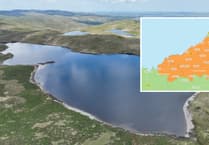Proof of shifts between extreme drought and heavy rainfall before a major climate tipping point has been found for the first time in ancient lake sediments by a research team including an academic from Aberystwyth.
The new study by a team including Professor Henry Lamb, from Aberystwyth University’s Department of Geography and Earth Sciences reveals that the sudden tipping point from humid to arid conditions in northern Africa 6,000 years ago was preceded by climatic ‘flickers’.
These flickers are a series of alternations between extremely wet periods and droughts, each lasting between 20 and 80 years, over a thousand-year period.
Published in the journal ‘Nature Communications’, the research analyses several wet–dry transitions in the 620,000-year environmental record from the Chew Bahir basin in the southern Ethiopian Rift.
Before now the flickering between wet and dry periods ahead of major climate transitions had previously only been predicted in theory.
The new findings point to the possibility of a future climatic tipping point, where the climate shifts suddenly and drastically to a new state.
These rapid environmental changes had a major impact on humans in northern Africa, as grasslands, open forests, and lakes disappeared.
That climate shift resulted in human populations becoming largely restricted to favourable habitats in mountains, oases and in the Nile Valley.
The international team, including Professor Lamb, collected 600,000-year-old samples from the sediments of Chew Bahir, a dry lake in south Ethiopia.
Prof Lamb said: “The confirmation of the existence of this extreme ‘flickering’ between wetness and drought several times in the past may provide insights into possible early warning signals for future large-scale climate tipping points.
“This is a real and dangerous possibility as human activity forces change in the climate system.
“This has happened in the past, with dramatic consequences for human populations, as our new data from south Ethiopia shows.
“The long core record we obtained shows that similar flickering climate also occurred in advance of much earlier transitions in the climate, implying that such tipping points can occur naturally, long before human impact on the climate.
“We see climate flickers as warning signals of the potentially catastrophic effects that future tipping points would have on the biosphere, including human populations.
“Clearly, it is important to consider current climate fluctuations as possible warning signs of climate breakdown, not just in Africa, but also in other sensitive climate systems such as the North Atlantic.”





Comments
This article has no comments yet. Be the first to leave a comment.